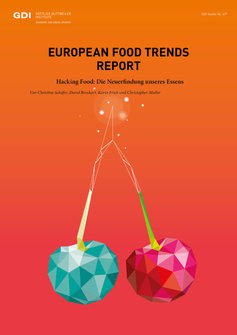Der nachfolgende Text basiert aus einem Auszug aus dem aktuellen «European Food Trends Report», den Sie über unsere Website beziehen können.
Unsere Essgewohnheiten sind nicht nur ressourcenintensiv, ungesund, widersprüchlich und inkonsistent. Sie unterliegen auch einem konstanten Wandel. Oder wie es die englische Kulturhistorikerin, Journalistin und Autorin Bee Wilson ausdrückt: «Nur sehr wenig davon, wie wir heute essen, wäre vor einer Generation als normal angesehen worden. Aber mich tröstet der Gedanke, dass vieles davon auch in Zukunft sicher nicht mehr normal scheinen wird.»
Unsere Aufmerksamkeit verschiebt sich entsprechend. Wir müssen Lösungen finden, wie wir die Ernährung von acht Milliarden Menschen sicherstellen können. Wir sind alle Teil eines grossen Ganzen, benehmen uns aber oft, als wären wir alleine auf dem Planeten. Es reicht nicht, unsere individuelle Erst-Welt-Sehnsucht nach Romantik, Authentizität und Natürlichkeit in den Fokus zu stellen – Stichwort Bauernmarkt und Bio-Abo. Wir müssen unser Food-System als Ganzes hinterfragen, globale Herausforderungen in den Blick nehmen und sie mit neuen Werten, Vernunft-basierten Entscheidungen und Tech-basierten Lösungen bewältigen.
Denn die Welt der Ernährung steht Kopf – auf allen Stufen der Wertschöpfung. Dies führt zu grossen Unsicherheiten und wirft Fragen auf. Welche Innovationen verändern die Art und Weise, wie Lebensmittel in Zukunft produziert und verarbeitet werden? Wie werden sie transportiert und vertrieben? Wie verändern sich Handel und Gastronomie? Wie, wann, wo, mit wem und was wollen Menschen in Zukunft essen? Welche Innovationen und Konzepte gibt es für mehr Nachhaltigkeit? Und wie fügt sich das alles zu einem funktionierenden System zusammen? Diese Fragen standen am Anfang der Erstellung der Food-Trendmap des GDI.
Die Food-Trendmap fasst die aktuellen Entwicklungen und Trends – die disruptiven Innovationen im gesamten Wertschöpfungsnetzwerk – zusammen und stellt sie grafisch dar. Als Basis für die Map dienten Interviews mit 39 ExpertInnen aus Europa, Nordamerika und Asien. Sie stammen aus unterschiedlichen Branchen – Technologie, Forschung, Produktion, Handel, Investment und mehr – und Unternehmensformen: von Startups und Grossunternehmen über Universitäten, Institute und Organisationen bis hin zu staatlichen Ämtern.
Die Trendmap fasst die Ergebnisse der ExpertInneninterviews zusammen. Die von den ExpertInnen genannten Trends und Innovationen werden den verschiedenen Wertschöpfungsstufen zugeordnet. Die Map unterscheidet zudem zwischen etablierten oder neu aufkommenden Trends. Die Grösse der Kreise gibt an, wie oft der jeweilige Trend genannt wurde.
GDI_Food_Trend_Map_0.pdfFür besonders wichtig halten die ExpertInnen auf allen Stufen der Wertschöpfung Tech-Themen. Bei der Produktion von Nahrungsmitteln geht es dabei vor allem um alternative Proteinquellen und Essen aus dem 3D-Drucker.
Die Verarbeitung von Lebensmitteln wird immer automatisierter und vernetzter. Neue Technologien wie das Internet of Things mit der Machine-to-Machine-Interaction, die Blockchain oder Robotics stehen dabei im Fokus. Gesundheit ist den KonsumentInnen wichtig, Fermentation und die Herstellung von Free-from-Produkten ohne Allergene sind daher besonders wichtig. Aber auch Cannabis-Drinks als eine Kategorie von Lebensmitteln, die erst dank gelockerter Regulierung und neuer Technologie in grossen Mengen produziert werden kann, gewinnen an Bedeutung.
GDI-Researcherin Christine Schäfer referiert zu Food- und Delivery-Trends an Ihrem Event – vor Ort oder online.
In Verkauf und Vertrieb dreht sich die Diskussion um Delivery. Ob frische Lebensmittel, vorportionierte Meal-Kits oder fixfertige Menüs – die Branche ist in einem wahren Lieferrausch. Dabei werden in Zukunft auch selbstfahrende Autos oder Lieferdrohnen wichtiger werden. Zudem entstehen mit Virtual und Augmented Reality neue Möglichkeiten in Verkauf, Vertrieb, Marketing und Kommunikation.
Für KonsumentInnen wird Transparenz wichtiger. Dank neuen Technologien sinken die Transaktionskosten von Informationen, man kann sich einfacher und schneller über Produkte und ihre Herkunft informieren. Weil Gesundheit nach wie vor grossgeschrieben wird, stehen auch individualisierte Menüs – bis hin zur Personalisierung der Menüs mittels DNA-Probe – weiterhin hoch im Kurs.

GDI-Studie Nr. 47 / 2019
Sprachen: Deutsch, Englisch

Farms, Labs and Beyond: Fixing a Broken Food System
– Die Konferenz findet online und auf Englisch statt –